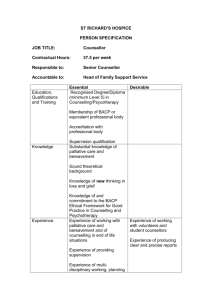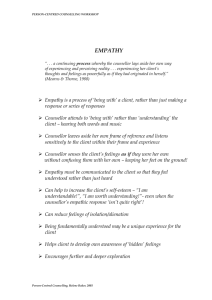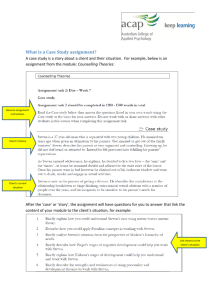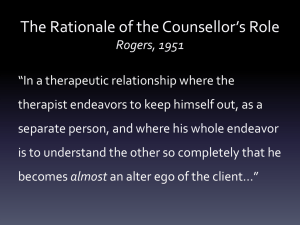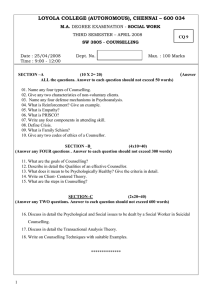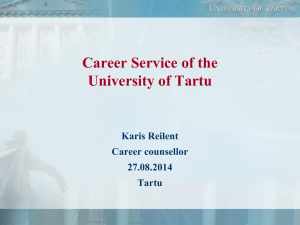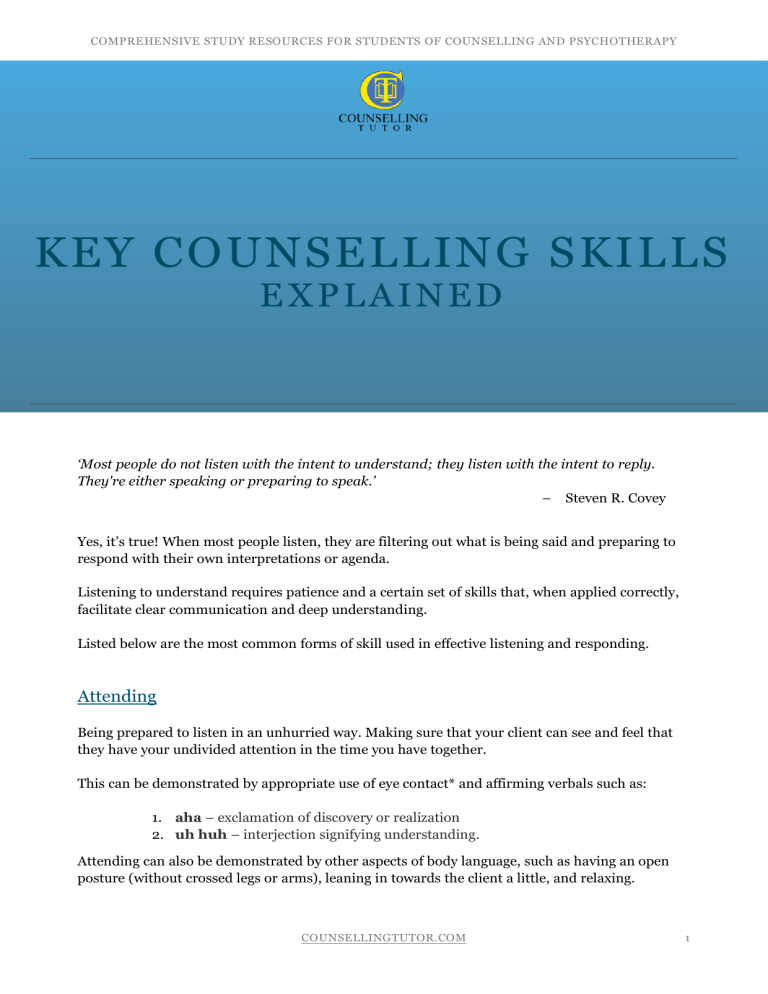
COMPREHENSIVE STUDY RESOURCES FOR STUDENTS OF COUNSELLING AND PSYCHOTHERAPY KEY COUNSELLING SKILLS EXPLAINED Most people do not listen with the intent to understand; they listen with the intent to reply. They're either speaking or preparing to speak. Steven R. Covey Yes, i true! When most people listen, they are filtering out what is being said and preparing to respond with their own interpretations or agenda. Listening to understand requires patience and a certain set of skills that, when applied correctly, facilitate clear communication and deep understanding. Listed below are the most common forms of skill used in effective listening and responding. Attending Being prepared to listen in an unhurried way. Making sure that your client can see and feel that they have your undivided attention in the time you have together. This can be demonstrated by appropriate use of eye contact* and affirming verbals such as: 1. aha exclamation of discovery or realization 2. uh huh interjection signifying understanding. Attending can also be demonstrated by other aspects of body language, such as having an open posture (without crossed legs or arms), leaning in towards the client a little, and relaxing. COUNSELLINGTUTOR.COM 1 COMPREHENSIVE STUDY RESOURCES FOR STUDENTS OF COUNSELLING AND PSYCHOTHERAPY Rapport building Is advanced attending skills. It includes offering empathy; having a welcoming and respectful manner; being a warm, genuine and real person in the relationship; and, most importantly, being non-judgemental towards your client. Building rapport takes time, and key elements of this process include preparing well for sessions, ensuring the environment is safe and tidy, remembering key information about the client, and mirroring. Silence Is perhaps the most underrated of all counselling skills. It can be used any time during the session. However, it is very effective at the start of the session when the client is talking about their issues or difficulties in life. The use of silence has two main functions: 1. It allows the client to tell their story and to feel heard and validated. 2. It allows the counsellor to gain a deeper understanding of the speaker i e , hile providing a useful space for the counsellor to consider appropriate responses to the clie . Silence can be uncomfortable for some people (both clients and inexperienced counsellors). It is important to explore during training how you feel about silence, and to be sensitive to any discomfort the client may feel. Paraphrasing This skill is used by the counsellor to reflect back the key points of the clie story. It is sometimes described as h ldi g up a mi to the client so they can hear their words repeated back to them. This skill has three functions: 1. I le he clie k a e a i g a e i a d hea i g hem. 2. The client can be sure that you have listened and gives an opportunity to correct or add information. 3. It gives the opportunity for the client to hear the power of their own words. Example: Client Valerie: My father is very ill and I am worried. He lives a long way away and I will have to get the train to see him. I really cannot afford the fare as I have very little money at the moment. COUNSELLINGTUTOR.COM 2 COMPREHENSIVE STUDY RESOURCES FOR STUDENTS OF COUNSELLING AND PSYCHOTHERAPY Counsellor Adeela: You are concerned about your fa he giving you money worries as well. health. Travelling to see him is Be thoughtful that paraphrasing is rewording the client s story in your own words. Avoid repeating back ha said word for word ha not paraphrasing. Tha parrot-phrasing! Reflecting Reflecting is a skill that can be used in conjunction with paraphrasing. This skill picks up on the emotion shown by the client as they are telling their story. Example: Client Valerie (clenching her fists): I d know why my father chose to live so far away from me when he knew how ill he was going to become. Counsellor Adeela: You seem angry at your father for moving so far away. Client Valerie: I am. I now have to travel halfway across the country to see him. He is so selfish. In the above interaction, you can see how reflecting and paraphrasing work together. Reflection can also take the form of using the client's own words to reflect back what they have said. To avoid parrot-phrasing, it is important to pick out just the key words; focusing on the words that convey emotion is usually a good strategy here. Empathy Sometimes referred to as he frame of efe e ce , it is the clie unique world view. By being empathic and emotionally alki g in the clie h e , a counsellor understands both the narrative and the felt emotion experienced by the client. This skill is sometimes referred to as li e i g to the music behind the words . Self-awareness (gained through personal development) is vital here in order to avoid getting 'pulled into' your own material, and so slipping back into your frame of reference. Focusing Is a useful skill if a client brings lots of issues to the session. By asking the client which issue is most pressing, the counsellor and the client have a clear understanding of what is being worked with. Usually, when the major issue is the f c of the work, other issues tend to fade away or resolve themselves. COUNSELLINGTUTOR.COM 3 COMPREHENSIVE STUDY RESOURCES FOR STUDENTS OF COUNSELLING AND PSYCHOTHERAPY Sometimes, especially if the client feels relief to finally have the opportunity to share their difficulties, they may pour out many issues very rapidly. This is particularly common during a first session. Focusng is valuable here, but you may not be able to use it straight away: the client may need first to pour everything out. Do of course tell them, though, if their pace is too fast for you to be able to attend properly. Clarifying Sometimes clients give a lot of information all at once that makes perfect sense to them but can be confusing for the counsellor to understand. Clarifying is a skill that uses a question to help the counsellor get a better understanding of the clie story. Example: Client Valerie: Tom has always been selfish. Counsellor Adeela: Who is Tom? Client Valerie: Tom is my fa he name. While it may feel difficult to 'interrupt' a client's story to clarify their meaning, it demonstrates that you really want to understand fully. It is also much easier to clarify at the time than to let the client continue and then to end up not understanding (or even misunderstanding) their story. Use of Questions In counselling, questioning should be used with the skill of clarifying and understanding, not to probe or interrogate the client. If questions are used, they should be open, not closed, questions. Examples: Closed question Are you feeling sad today? Open question How are you feeling today? By using open questions, you allow the client to speak more about the issues as opposed to responding to a closed question with a yes or no answer. Always check in with your yourself before asking a question, to ensure that your reason for asking is in the client's service and not, for example, to satisfy your own curiosity. It's a good idea too to avoid 'why' questions, which can sound judgemental of the client's actions, decisions etc. COUNSELLINGTUTOR.COM 4 COMPREHENSIVE STUDY RESOURCES FOR STUDENTS OF COUNSELLING AND PSYCHOTHERAPY Summarising This skill is used towards the end of the session and is effectively a longer paraphrase. It is a useful way for the counsellor to reflect the key points of the session before bringing it to a respectful close. Try to keep the summary brief, but meaningful and a true reflection of the material that the client has brought to the session. Summarising can also be used to start a second or subsequent section, showing that you recall the previous session and reminding the client of previous work. It is important, however, not to make the client feel that they must continue the same thread (unless perhaps you are working in an active-directive modality). Immediacy Feltham and Dryden (1993: 88) describe immediacy as he key skill of focusing attention on the here and now relationship of counsellor and client with helpful timing, in order to challenge defensiveness and/or heighten a a e e . Using immediacy means that the therapist reveals how they themselves are feeling in response to the client. Fi all Listening to understand instead of listening to respond, is the basis of forming a trusting, mutually respectful relationship in which clients feel safe and secure enough to discuss difficult issues. When this happens and the above skills are used properly, clients can see and embrace the changes in their lives. *Eye contact - In Western cultures, looking someone in the eye is seen as a sign of honesty, integrity or undivided attention. In certain Asian cultures, however, it can be seen as a sign of disrespect or rudeness. When using counselling skills, always be culturally aware. COUNSELLINGTUTOR.COM 5
